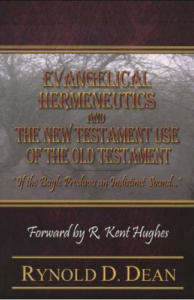
Author: Dean, Rynold
Genre: Theology - Dispensationalism
Tags: Dispensationalism, dispen
Series:
Rick Shrader‘s Review:
Rynold Dean is a graduate of The Master’s Seminary and holds a traditional dispensational approach to hermeneutics. This volume is a continuation of his Master’s thesis and following years of additional writing. The book is endorsed by John MacArthur, R.L. Thomas, and Mike Stallard, with a forward by R. Kent Hughes. Dean tackles the controversial topic of how the New Testament writers quote and use the Old Testament writers. He begins in chapter one by giving his own view of proper hermeneutics described as context, meaning, and inspiration. Dean’s view is a traditional grammatical-historical view of interpretation centering on the divine use of language and communication which God Himself created within human beings and used in delivering Scripture.
The bulk of the book is given to describing six approaches to the use of the OT in the NT. The first is the “Contemporary Judaism/Second Temple Herneneutics School” represented by Richard Longenecker and Peter Enns. The second is the “Divine-Human Words School” by J.I. Packer and Elliot Johnson. The third is the “Canonical Process/NT Priority School” prepresented by Bruce Waltke and Douglas Oss. Dean says, “The first three approaches . . . each propose, in some fashion, that when a NT writer cites an OT text–in a way that seems to supercede or contradict its original meaning–he is revealing an actual meaning of the original OT passage, possibly, irresprective of whether the OT writer himself understood this meaning when he wrote.” These three approaches violate the OT context by adding meaning, oftten from outside the biblical material, when the passage is quoted in the NT.
The next three approaches are, fourth, the “Full Human Intent School” of Walter Kaiser. the fifth is the “Biblical Intertextuality Prophetic Hermeneutic School” of Abner Chou. Sixth is the “Inspired Subgectivity/Inspired Sensus Plenior Application School” of R.L. Thomas. Dean says, “The last three positions in this study argue differently. Each of these three is fully convinced that one determines the correct meaning of an OT passage in its original setting by strictly adhering to the immediate OT context in the interpretive process.” These three approaches hold more strictly to the context of the OT passage in the NT quotation, not reading into or adding other meaning. These approaches are not easily understood or recognized by the lay reader. Volumes are written and are being written from these and related approaches. Dean gives the reader an approach that keeps the contextual meaning of the OT in tact, and sees the NT use of that passage in its proper historical/grammatical sense (see chapter 5, Summary and Conclusion, especially page 208-209).
